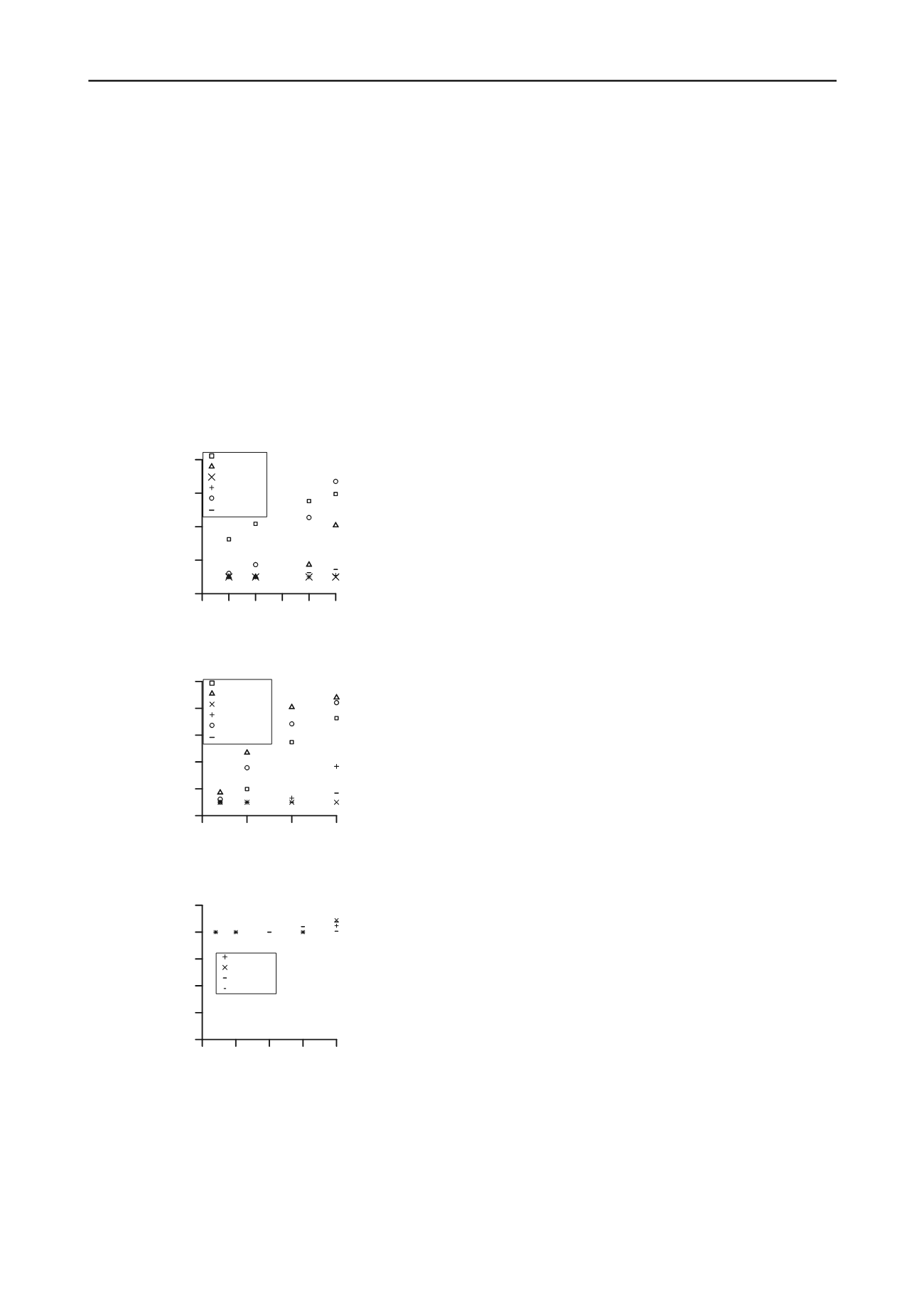
2636
Proceedings of the 18
th
International Conference on Soil Mechanics and Geotechnical Engineering, Paris 2013
be explained as below. For high cement content and low water
content, there is stronger interaction between PVA fiber and
cement-soil body due to PVA’s higher strength, which results in
higher ductility in long PVA fiber reinforced soil specimens.
For high cement and water content, there is high PP fiber
concentration due to PP’s higher aspect ratio, which induces
lower ductility in long PP fiber reinforced soil specimens.
4 CONCLUSIONS
Based on the results and analysis, the main conclusions may be
drawn as below.
For 6mm fiber reinforcement, Figure 7b shows that for low
water content (100%) and high cement content (50%), PVA
fiber gives lower BI values at four different strain levels
between 2%-15% than PP fiber. For low cement content (20%)
and low water content, PVA gives higher BI values than PP
fiber. This suggests that short PP fiber interacts with cement-
soil body better than PVA fiber of the same length, at low
cement and water content. Figures 7b-7c also show that for mid-
high cement (35%) and low water content or high cement and
mid to high water content, fiber type effect is very small.
Therefore, short PVA fiber generally gives ductility not lower
than PP fiber except for low cement content and low water
content.
The strength and ductility of cement-treated marine clay was
improved significantly by fiber reinforcement. There is
optimum fiber content, considering performance and
workability of cement-treated soil specimens. PVA fiber
reinforcement is generally better than PP fiber reinforcement
except for low cement content and water content.
It was observed that the fiber cut length has significant effect
on the ductility of cement-treated soil. However, the cut length
effect on strength for PP fiber reinforcement is much smaller
than that for PVA fiber reinforcement.
5 ACKNOWLEDGEMENTS
This research is supported by the National Research Foundation
Singapore under its Competitive Research Programme (CRP
Award No. NRF-CRP 6-2010-03).
0 5 10 15 20 25
Axial strain (%)
0.95
1.05
1.15
1.25
1.35
Brittleness index
2:1:3-PP12
2:1:3-PVA12
2:1:4-PP12
2:1:4-PVA12
2:1:5-PP12
2:1:5-PVA12
5 REFERENCES
Consoli, N.C., Prietto, P.D.M., Ulbrich, L.A. 1998. Influence of fiber
and cement addition on behavior of sandy soil. Journal of
Geotechnical and Geoenvironmental Engineering 124 (12), 1211–
1214.
Consoli, N.C., Vendruscolo, M.A., Prietto, P.D.M. 2003. Behavior of
plate load tests on soil layers improved with cement and fiber.
Journal of Geotechnical and Geoenvironmental Engineering, ASCE
129 (1), 96–101.
(a) Brittleness index versus strain for 12mm long fiber reinforcement
(fiber content, 0.16%).
Consoli, N.C., Zortéa, F., Souza, M., Festugato, L. 2011. Studies on the
dosage of fiber-reinforced cemented soils. Journal of Materials in
Civil Engineering, ASCE 23 (12), 1624-1632.
Gray, D.H., Ohashi, H. 1983. Mechanics of fiber reinforcement in sand.
Journal of Geotechnical Engineering 109 (3), 335–353.
0
5
10
15
Axial strain (%)
0.98
1.02
1.06
1.1
1.14
1.18
Brittleness index
2:1:3-PVA6
2:1:3-PP6
20:7:27-PVA6
20:7:27-PP6
5:1:6-PVA6
5:1:6-PP6
ISO/TS 17892, 2004. Geotechnical investigation and testing -
Laboratory testing of soil. International Organization for
Standardization, Edition 1, Part 7-9.
Khattak, M. J., & Alrashidi, M. 2006. Durability and mechanistic
characteristics of fiber reinforced soil-cement mixtures.
International Journal of Pavement Engineering 7(1), 53-62.
Maher, M.H., Ho, Y.C. 1993. Behavior of fiber-reinforced cement sand
under static and cyclic loads. Geotechnical Testing Journal 16 (3),
330–338.
(b) Brittleness index versus strain for 6mm long fiber reinforcement
(low water content, 100%; cement content, 20%-50%; fiber content
0.24-0.32%).
Park, S. S. 2009. Effect of fiber-reinforcement and distribution on
unconfined compressive strength of fiber-reinforced cemented
sand. Geotextiles and Geomembrane 27, 162-166.
Tang, C., Shi, B., Gao,W., Chen,W. and Cai, Y. 2007. Strength and
mechanical behavior of short polypropylene fiber reinforced and
cement stabilized clayey soil. Geotextiles and Geomembranes 25
(3), 194–202.
0
5 10 15 20
Axial strain (%)
0.92
0.94
0.96
0.98
1
1.02
Brittleness index
2:1:4-PVA6
2:1:4-PP6
2:1:5-PVA6
2:1:5-PP6
Ud-din S., Marri A. and Wanatowski D. 2011. Effect Of high confining
pressure on the behaviour of fibre reinforced sand. Geotechnical
Engineering Journal of the SEAGS & AGSSEA 42(4), 69-76.
(c) Brittleness index versus strain for 6mm long fiber reinforcement
(mid to high water content, 133%-167%; high cement content, 50%;
fiber content, 0.24%).
Figure 7. Effect of fiber type on ductility for RFCT soil specimens with
20%-50% cement content, 100%-167% water content, fiber cut length
6-12mm and 0.16-0.32% fiber.
In summary, as Table 2 shows, by considering of the
strength and ductility of FRCT soil specimens, PVA fiber
reinforcement is generally better than PP fiber except for low
cement content and water content.


